
HandmadePictures/iStock/Getty Images
Baking potatoes may seem like a no-brainer. Put the potatoes in the oven; bake them. In truth, baking potatoes is a bit more difficult than you might imagine. The type of potato -- not any potato will do -- the temperature, cooking method and seasonings matter as much in preparing a baked potato as they do in more complex dishes.
Starch and Moisture Content
Since white, or Irish, potatoes have a medium starch content and a medium moisture content, they're sometimes referred to as "all-purpose" potatoes. While they may not get as fluffy inside as a high-starch russet, white potatoes still make excellent bakers. Once baked, the white potato's low-sugar content yields a sightly dense flesh that's not too firm and more creamy than fluffy.
If you like your potatoes more fluffy than creamy, go for a high-starch potato such as a russet. Waxy or low-starch potatoes create a very dense flesh when baked. They can be baked but work well in roasted potato dishes.
Foil or No Foil
Some cooks always wrap their potatoes in foil, while others say it's unnecessary: It's personal preference. Wrapping potatoes in foil holds in steam, which makes your potato sightly more dense, with a texture closer to a boiled potato. This texture holds up better with denser toppings such as heavy cheeses, bacon or chili. If you leave off the foil, you'll get a crispier skin and a lighter, fluffier flesh that works well with the classic toppings: butter, sour cream and chives.
Baking Basics
Thoroughly wash and scrub the skins to remove any dirt. Once cleaned, poke each potato with a fork about three to five times to let excess steam escape. Next, rub each potato with olive oil and sprinkle it with sea salt. If you're using foil, wrap each potato individually. Bake them on a cookie sheet or directly on the oven rack at 450 degrees Fahrenheit for an hour. If a fork pierces the potato easily, it's done. If not, recheck every 5 minutes until they're done. If you have a food thermometer, you can check to see if the internal temperature of your potato has reached between 208 and 211 degrees F according to the Idaho Potato Commission.
Roasted Potatoes
For roasted potatoes, cut four to five medium-sized potatoes into uniform 1-inch chunks. Place the potatoes into a casserole dish. Drizzle about 4 tablespoons of olive oil over the potatoes; then add seasonings such as garlic, seasoned salt, Parmesan cheese, rosemary or salt and pepper. Bake your potatoes at 400 degrees F for 20 minutes; then flip them and cook them for another 20 minutes or until they're fork-tender all the way through.
Related Articles
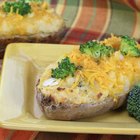
Can You Over-Bake a Potato?

How to Cook Potatoes for Eight Hours in ...

How to Cook French Fries on a Baking ...

Baking Potatoes With Potato Nails
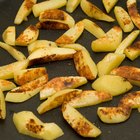
How to Sautee Potatoes
How to Steam Cook a Potato
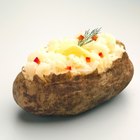
How to Cut Baked Potatoes

How to Cook Potatoes for Eight Hours in ...

How to Cook Small Dutch Yellow Potatoes

The Best Potatoes For Shredded Hash ...

How to Make a Foil Wrapped Potato
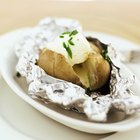
Do Baked Potatoes Have a Lot of Fiber?

What Are Yellow Potatoes?

How to Smoke Potatoes

Cooking Time for Baked Potatoes Wrapped ...
Does a Baked Potato Cook Faster if You ...
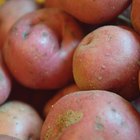
How to Cook Petite Red Potatoes

How to Bake a Potato Without an Oven

Raw Potato for Wrinkles

Ways to Cook Baked Potatoes Without Foil
References
- The Kitchn: How to Bake Potatoes: Three Easy Methods
- The Kitchn: How to Bake Potatoes in the Oven
- Southern Living: How to Bake the Perfect Potato
- Culinary Institute of America: Potato Types Guide
- Fine Cooking: Picking the Perfect Potato to Mash, Bake, or Broil
- Epicurious: Herb-Roasted Potatoes
- Idaho Potato Commission: Frequently Asked Questions
Writer Bio
A Jill-of-all-trades, Lillian Downey is a certified Responsible Sexuality Educator, certified clinical phlebotomist and a certified non-profit administrator. She's also written extensively on gardening and cooking. She also authors blogs on nail art blog and women's self esteem.
Photo Credits
HandmadePictures/iStock/Getty Images